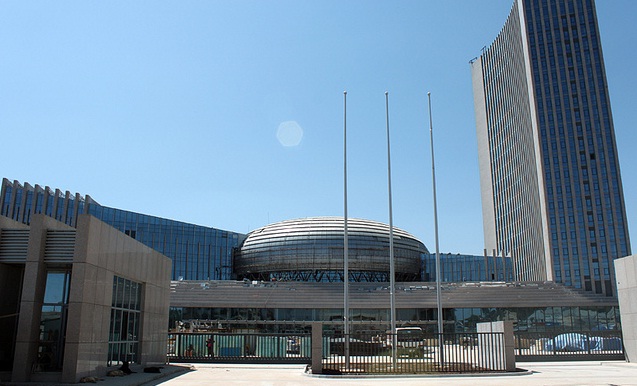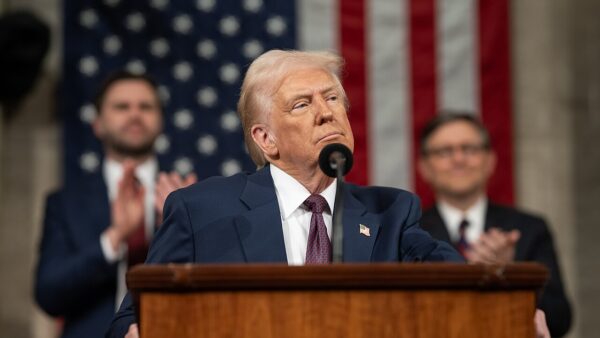China’s investment in Africa over the last 13 years has given it a worrying advantage, a new report to Congress finds. By Rod Sweet.
“Our dream came true, and we are now overlooking a modern architectural jewel symbolising the historical relations between China and our continent.”
That was Dr Jean Ping, Gabonese diplomat and chairman of the African Union Commission, speaking in January 2012 at the opening of the AU’s brand new $200m headquarters in Addis Ababa.
The fact that Dr Ping himself is half Chinese – son of a Gabonese woman and a Chinese trader – may have added warmth to his words.
But whoever spoke that day would have had to acknowledge that the AU’s gleaming new complex was built and paid for – as a gift – by China.
It’s a potent symbol of a dilemma America seems now to be waking up to.
Economically and diplomatically, the 49 states of sub-Saharan Africa, which include four of the world’s 10 fastest growing economies (between 2001 and 2011), are now firmly oriented eastward, to China.
At the request of concerned legislators, the US Government Accountability Office (GAO), the audit and investigative body for Congress, has produced a report comparing the two countries’ relative standing in the region, and how they got there.
Sub-Saharan Africa: Trends in US and Chinese Economic Engagement will make uncomfortable reading in America.
It shows that China’s heavy investment over the last 13 years in loans and grants for infrastructure development have given it a distinct advantage.
It also shows that Chinese-facilitated construction has been a precursor for deeper economic engagement.
And it warns that while the US can take comfort now in the fact that it dominates higher-tech services, there is no telling what will happen when China upskills and the two countries can no longer keep out of each other’s way.
Â
Prized amenities
China overtook the US as the region’s biggest trading partner in 2009.
Between 2001 and 2011, American exports to the region did well, tripling from $6.8bn to $20.3bn.
But in the same period Chinese exports grew by a factor of nearly 13, from $4.4bn to $56.3bn.
To understand what’s driving China’s deeper engagement there the GAO looked in detail at three countries, Angola, Ghana and Kenya.
It found that Chinese government financing in Angola between 2002 and 2011 exceeded that of the US by more than $11bn.
In Ghana, Chinese loans between 2006 and 2011 exceeded US financing by more than $2.4bn, while in Kenya Chinese largesse in the much shorter period from 2009 to 2012 exceeded US financing by more than $77m.
It also found big differences in what the money was spent on. Chinese financing primarily went to roads, rail, hospitals, schools, housing, and water and energy infrastructure – all built by Chinese firms, including state-Âowned ones.

The AU’s brand new $200m headquarters in Addis Ababa
American financing, by contrast, generally supported the purchase of US exports, including aircraft and machinery.
“US officials observed that China’s infrastructure construction addresses a key need in Africa,” the report noted.
As well as loans, China also provides outright grants for amenities highly prized either by the public, or by governments.
It gave nearly $39m in grants to Kenya from 2009 to 2012 for new roads, a sports stadium and a hospital. In 2011 it gave Ghana $15m for a new Ministry of Foreign Affairs building.
Again, these are built by Chinese firms.
The report finds more key differences between the stated foreign policy goals behind each country’s approach to Africa.
America’s is a mix of value-laden, sometimes abstract objectives that cross multiple US agency jurisdictions.
They include: “strengthening democratic institutions”, “building respect for human rights” and improving “health and education indicators”.
China’s goals are simple – “establishing closer ties with African countries by seeking mutual benefit for China and African nations and by following a policy of noninterference in countries’ domestic affairs”.
In other words, China is there to do business, of a seemingly win-win nature, with no questions asked.
A striking example is the $9bn loan extended to the Democratic Republic of the Congo (DRC) in 2008.
The deal was to result in 9,000km of new roads and rail, along with schools, hospitals, housing and other infrastructure, plus the rehabilitation of the DRC’s cobalt and copper mines.
Crucially for China, the package included lucrative mining rights for the Chinese consortium involved.
Â
Don’t even try
The GAO notes that US officials worry that China’s approach will disadvantage US firms, and confirms that it does.
It finds that Chinese firms have established themselves and expanded in the region as a result of whatever state-sponsored project first brought them there.
Kenyan officials say China’s investments have gone up because Chinese firms stayed and diversified into other sectors.
The report observes that Chinese firms are less bothered by political risk and corruption, and are willing to accept lower returns on investment.
It notes that Chinese firms bid low because they get higher productivity from workers and deploy materials and equipment from already established projects nearby.
As a result, the report’s authors found, some US firms don’t even try to compete with Chinese firms for infrastructure projects because they feel it’s “extremely difficult”.
Â
“Aggressive and pernicious”
In 2010, US Embassy cables obtained by Wikileaks and published by the Guardian newspaper quoted US assistant secretary for African affairs, Johnnie Carson, as saying: “China is a very aggressive and pernicious economic competitor with no morals.”
In contrast, the GAO report is strenuously neutral in tone, but the authors do allow themselves one actual warning.
Currently, US and Chinese firms rarely compete in Africa because U.S. firms focus on higher-technology areas.
But this could change.
“Increases in Chinese technological capacity could affect U.S. and Chinese commercial engagement in some sectors of sub-Saharan Africa in ways that are not easily known at this time,” the report says.
Concluding, the GAO allows itself one, careful policy hint.
Noting that the US recently “elevated the importance” of commercial engagement in sub-Saharan Africa, it said: “This reprioritization reflects this region’s prospects for economic growth as well as the perspective that advancing US interests can benefit from a stronger integration of commercial goals with diplomatic engagement.”
In other words, perhaps: Time to get off your high horse, and with the programme.










